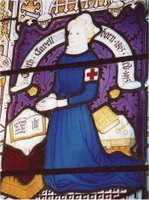Intimations of Immortality

Edith Cavell was born in 1865 in the vicarage of Swardeston in rural Norfolk, a few miles from where I write these words. She was an accomplished artist, and had a flair for French. After several jobs as a governess in England she was recommended for a post in Brussels in 1890.
In 1895 she returned to nurse her father through an illness, and it was this experience that led Edith to take up nursing. In 1905 she returned to Brussels and was
 put in charge of a pioneering training school for lay nurses on the outskirts of the city. Edith often returned to visit her mother who moved to Norwich after her husband's death. While on a visit in 1914 she heard of the German invasion of Belgium, but she returned to her hospital without hesitation.
put in charge of a pioneering training school for lay nurses on the outskirts of the city. Edith often returned to visit her mother who moved to Norwich after her husband's death. While on a visit in 1914 she heard of the German invasion of Belgium, but she returned to her hospital without hesitation.In the autumn of 1914, two stranded British soldiers found their way to Nurse Cavell's training school. Others followed and were spirited away to neutral territory in Holland. An underground lifeline was established, masterminded by Prince and Princess De Croy at a chateau in Mons, and some two hundred soldiers were helped in their escape.
Two members of the escape team were arrested on 31 July 1915, and five days later Nurse Cavell was interned. The German military
 authorities, having tried in secret and sentenced Edith and four others to death, were determined to carry out the executions immediately. Despite frantic efforts to save her, by the American and Spanish ambassadors to Belgium, Edith was executed by firing squad at a rifle range just outside Brussels at dawn on 12th October 1915 after a last visit from the English Chaplain.
authorities, having tried in secret and sentenced Edith and four others to death, were determined to carry out the executions immediately. Despite frantic efforts to save her, by the American and Spanish ambassadors to Belgium, Edith was executed by firing squad at a rifle range just outside Brussels at dawn on 12th October 1915 after a last visit from the English Chaplain.The Allies acclaimed Nurse Cavell as a martyr, and the stained glass window above was installed by public subscription in Swardeston Church in 1917. After the war her remains were brought to Westminster Abbey. A special train then brought her to Norwich, and a great procession followed her to the Cathedral where she was laid to rest. My photograph of her grave was taken a few days ago early on a wonderful May morning.
Now playing - Intimations of Immortality, Gerald Finzi's setting of the poem by the seventeenth-century metaphysical poet Thomas Traherne which
 laments the severing of the adult soul from the intuitive primal state. This year marks the fiftieth anniversary of Finzi's premature death at the age of just fifty-five. Hyperion's superb recording features tenor John Mark Ainsley and the Corydon Singers and Orchestra conducted by Matthew Best.
laments the severing of the adult soul from the intuitive primal state. This year marks the fiftieth anniversary of Finzi's premature death at the age of just fifty-five. Hyperion's superb recording features tenor John Mark Ainsley and the Corydon Singers and Orchestra conducted by Matthew Best.Additional resources* Edith Cavell website * Gerald Finzi Trust * Image credit: Header photot by Pliable, Edith Cavell from Alamo Community College Swardeston Church window from Edith Cavell website. Any copyrighted material on these pages is used in "fair use", for the purpose of study, review or critical analysis only, and will be removed at the request of copyright owner(s). Report broken links, missing images and other errors to - overgrownpath at hotmail dot co dot uk
If you enjoyed this post take An Overgrown Path to Childhood luggage








Comments